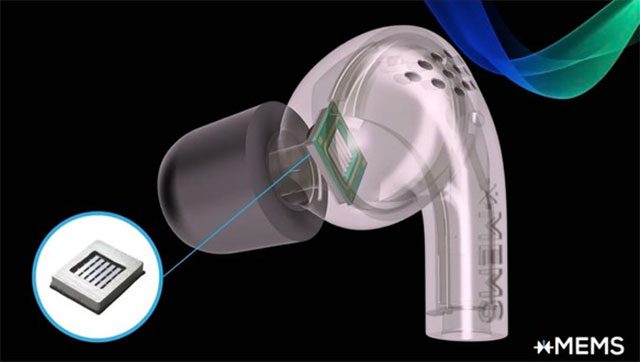Say goodbye to conventional headphones; the new ultrasonic headphones offer superior noise cancellation and spatial sound quality.
These headphones could finally surpass century-old technology thanks to a new type of ultrasonic microchip. This innovative audio chip may pave the way for noise-canceling headphones that can also recreate the illusion of sound coming from multiple directions.

The startup company xMEMS first introduced its Cypress headphones at CES 2024 on January 9. (Image: xMEMS).
The startup company xMEMS unveiled the Cypress audio chip—measuring approximately 6.3 x 6.5 mm—at CES 2024 on January 9. It is expected to be incorporated into in-ear headphones by the end of next year, according to company representatives.
In conventional speakers, a metal coil is wrapped around a magnet, and an electric current runs through the coil. The electromagnetic field generated by the current interacts with the magnetic field of the permanent magnet, pushing the coil back and forth like a piston. This coil is also attached to the speaker cone or diaphragm, which pushes air to create sound. This technology was first proposed in the 1800s, but it is still used in headphones today.
However, speakers designed this way are prone to damage, wear, and issues like phase distortion—where the shape of the sound waveform changes during signal conversion, causing delays and resulting in muffled sound.
In contrast, the Cypress micro-speaker is a silicon chip with two components: an application-specific integrated circuit (ASIC) that processes the electromagnetic signals from audio files, and an ultrasonic transducer.
The transducer is made from micro-electromechanical systems (MEMS)—extremely small machines that combine electronic and mechanical components. They are widely used in consumer electronics such as buzzers and receivers.
Similar to older technologies, the Cypress transducer moves air to generate sound waves. However, unlike most MEMS made from piezoelectric crystals or ceramics, Cypress employs a new type of thin piezoelectric film made from lead zirconate titanate (PZT).
PZT is integrated as a layer in the semiconductor manufacturing process along with the silicon speaker diaphragm. Company representatives stated that when applied this way, the membrane can produce high-resolution, high-quality sound.
xMEMS representatives mentioned in a statement: unlike conventional speakers, the phase output of the speaker is nearly zero, making it more suitable for features like spatial audio, simulating the experience of being surrounded by speakers in different positions.
The Cypress chip can also be used to create better noise-canceling technology, generating sound waves that effectively eliminate surrounding noise. Theoretically, Cypress’s faster mechanical response and phase combination close to zero would allow for the cancellation of higher frequency noise issues that current headphones face. This movement in the Cypress chip also generates more energy and pressure at lower frequencies—40 times more than previous non-ultrasonic speaker chips—equipping it with the necessary noise-canceling capabilities to eliminate these sounds.
Following the demonstration at CES, xMEMS has begun sending samples to several of its clients. The company plans to release the production-ready version of the Cypress chip in June 2024. Mass production may start by the end of 2024 or early 2025, with in-ear headphones featuring this chip expected to be available by the end of 2025.


















































